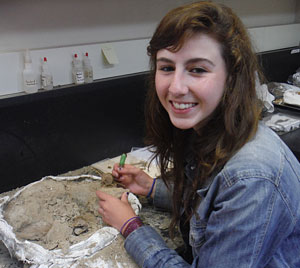By Elena Stiles | PCP PIRE intern
I first became interested in geology when I took an introductory geosciences class in my second year of college at the University of the Andes in Bogotá, Colombia. I was studying Industrial Design and not quite loving it, so I followed my mom’s suggestion to explore the new Geosciences major that had just opened at my school. The fact that you could read Earth’s past in the rocks fascinated me, and immediately I enrolled in the program. At the end of my first semester, through my geology professor Camilo Montes, I had the opportunity to travel to Panama and work as a volunteer at the CTPA (Center for Tropical Paleoecology and Archaeology) at STRI for a month. During my time in Panama I worked alongside the STRI staff and the PCP-PIRE team that was working there at the time, collecting and preparing fossils from the Panama Canal. This is where I learned about the importance of the closure of the Isthmus of Panama, the mystery that still hangs over it and how the fossil record is a key source of information about the past.

Growing up with ornithologist parents had started to manifest itself in my interests in spite of my adolescent attitude. Paleontology, what seemed to be the perfect mix between geology and biology, had started to grow on me. My interest in paleontology grew as I went back to school, so I decided to apply for the PCP-PIRE internship program. This seemed like a great opportunity to not only gain field experience and to live and work in a foreign country, but to explore and learn more about paleontology. I am now part of the fall 2013 intern team, and we spend our days collecting and prepping fossils from the Canal Zone and other areas of Panama.
I am also working on a small research project as my undergraduate thesis, in which I will survey the trace fossils in the Pliocene Chagres Formation to gain more information about the depth at which this formation was deposited. The Chagres formation outcrops on the Caribbean coast of Panama, so working on this project has given me the opportunity to travel to different parts of the country and travel to new fossil sites.
After I finish this internship in December, I’ll be going back to school to finish my undergraduate degree and hopefully remain involved with PCP-PIRE research. This internship has been a great learning and personal experience, and I will continue to make the most of the time I have left here and I hope to be leaving with new friendships and connections for the future.
Por Elena Stiles | PCP PIRE Pasante
Me interesé por primera vez en la geología cuando tomé una clase introductoria de ciencias de la tierra en mi segundo año de pregrado en la Universidad de los Andes en Bogotá, Colombia. Estaba estudiando diseño industrial y no me gustaba mucho, así que seguí la sugerencia de mi mamá de explorar el nuevo programa de Geociencias que se acababa de abrir en mi universidad. El hecho de poder leer el pasado de la Tierra en las rocas me fascinó y de inmediato me inscribí en el programa. Al final de mi primer semestre, a través de mi profesor de geología Camilo Montes, tuve la oportunidad de viajar a Panamá y trabajar como voluntaria en el CTPA (Centro de Paleoecología y Arqueología Tropical) en STRI por un mes. Durante mi estancia en Panamá trabajé junto al personal de STRI y el equipo PCP-PIRE que estaba trabajando allí en ese momento en la recolección y preparación de fósiles del Canal de Panamá. Ahí fue donde aprendí sobre la importancia del cierre del istmo de Panamá, el misterio que todavía se cierne sobre él y cómo el registro fósil es una fuente clave de información sobre el pasado.

Crecer con padres ornitólogos ha comenzado a manifestarse en mis intereses, a pesar de mi mala actitud en la adolescencia. El interés en la paleontología, lo que parecía ser la mezcla perfecta entre la geología y la biología, ha comenzado a crecer en mí. Mi interés por la paleontología creció cuando regresé a mis estudios, así que decidí aplicar al programa de prácticas del PCP-PIRE. Esto parecía una gran oportunidad no sólo para ganar experiencia de campo y de vivir y trabajar en un país extranjero, sino para explorar y aprender más acerca de la paleontología. Ahora soy parte del equipo de pasantes del otoño 2013 y pasamos nuestros días recogiendo y preparando los fósiles del área del Canal y otras áreas de Panamá.
También estoy trabajando en un pequeño proyecto de investigación para mi tesis de grado, en el que voy a estudiar las trazas fósiles en la Formación Chagres del Plioceno para obtener más información acerca de la profundidad en la que se depositó esta formación. La formación Chagres aflora en la costa caribeña de Panamá, por lo que trabajar en este proyecto me ha dado la oportunidad de viajar a diferentes partes del país y viajar a nuevos sitios fosilíferos.
Después de terminar la pasantía en diciembre, volveré a la universidad para terminar mi licenciatura y espero seguir participando en la investigación del PCP-PIRE. Esta práctica ha sido un gran aprendizaje y experiencia personal, y seguiré aprovechando al máximo el tiempo que me queda aquí y espero irme con nuevas amistades y conexiones para el futuro.